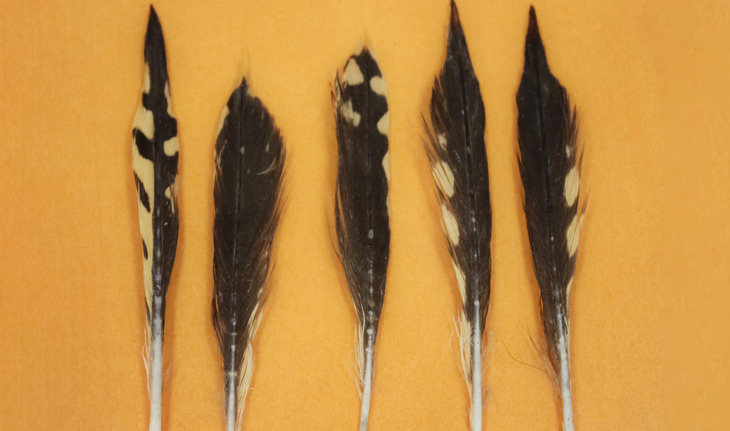Tiger sharks feast on migratory birds that fall out of the sky
Other marine animals don’t appear to target land birds that end up in the Gulf of Mexico

GREAT LENGTHS To find out what tiger sharks eat, fisheries ecologist Marcus Drymon (right) and colleagues dissected dead sharks and got live sharks to give up their stomach contents. Migratory birds turned up in about 40 percent of the sharks.
M. Drymon
- More than 2 years ago
It all started when a small tiger shark barfed up a bunch of feathers.
Marcus Drymon, a fisheries ecologist at Mississippi State University in Biloxi, had been catching sharks as part of a long-term shark monitoring program in the north-central Gulf of Mexico. Typically, a shark spent only about 90 seconds out of the water, enough time for scientists to weigh and tag it before releasing it. But one day in 2010, a tiger shark, perhaps stressed by the experience, left its stomach contents on the boat’s deck.
“Being the science nerd I am, I scooped up all the feathers, all [that] tiger shark barf, and put it in a bag and took it back to the lab,” Drymon says.
Little did he know that those stomach contents would lead to a discovery about how young tiger sharks take advantage of bird migrations to get a free meal.
First, Drymon wanted to know what bird species the feathers had come from. So he reached out to an old friend, molecular ecologist Kevin Feldheim of the Field Museum in Chicago. Feldheim usually looks at shark DNA to study relationships between individual sharks. But he agreed to try to identify the feathers with DNA barcoding, a technique that lets scientists identify a species based on a short strand of mitochondrial DNA. The analysis showed that the feathers came from a brown thrasher, a type of terrestrial songbird.
Intrigued, Drymon searched the scientific literature, finding a handful of reports of tiger sharks eating terrestrial birds, and he decided to investigate how prevalent these meals were. During monthly surveys from 2010 to 2018, he and his colleagues collected the stomach contents from 105 tiger sharks — by dissecting dead sharks and washing out the stomachs of live ones — and sent them to Feldheim for analysis.
Some of the samples “smelled pretty bad,” Feldheim says, “because they’re just what the shark was digesting at the time.” Barely digested feathers weren’t too bad, and were easy to extract DNA from. “But others were, you could just tell. You could just take it out of the jar and it just smelled horrible. And those were usually very difficult to extract from,” he says.
Forty-one, or 39 percent, of the sharks contained bird remains from 11 species: eight songbirds (including barn swallows and house wrens) along with white-winged doves, yellow-bellied sapsuckers and the American coot, the only water bird of the bunch, the researchers report online May 21 in Ecology.
“When he started sending me feathers, I just assumed they would all be seabirds like gulls or pelicans or something like that,” Feldheim says.

The part of the Gulf where Drymon works is near the last spot migratory birds can land before they take off for Mexico in the fall. It’s also the first spot that many can land in the spring after their marathon flight across the water. Drymon at first thought that the birds might be the ones that don’t quite make it to land in the spring. But when he looked at the timing of when the birds showed up in the sharks, he could see that most of the birds were eaten in the fall. “That was a puzzle,” he says.
And so Drymon reached out to Mississippi State colleague Auriel Fournier, an ornithologist, to make sense of it all. They consulted eBird, an online database of bird sightings, and hashed it out with other colleagues over lunches. The birds, the researchers determined, must take off for their journey south and then get caught when the weather unexpectedly turns nasty. And unlike ducks and other water birds, the species found in the sharks can’t keep themselves dry once they hit the water. So if they’re knocked out of the sky by something like a storm, they become shark bait, Drymon and his colleagues propose.
“It made sense within what we know about bird migration,” Fournier says. “It’s just a piece of the puzzle that we didn’t know about.”
So, are these birds feeding other species in the Gulf, too?
No, Drymon says. “I’ve looked at the stomachs of so many other species of shark, so many other species of bony fish, and none of them eat these terrestrial birds, or marine birds for that matter, the same way that the tiger sharks do.”
The birds’ fall migration does coincide with a peak in the young tiger shark population in the north-central Gulf of Mexico. And about half the sharks that had birds in their bellies were in fact baby sharks. Drymon and his colleagues now think that mama sharks have figured out that the area is a good time and place to give birth because it lets their young access an easy-to-obtain food source before they’ve fully honed their hunting skills.
That idea fits with tiger sharks’ will-eat-anything reputation, Drymon says. “I don’t like it necessarily when people say tiger sharks are the trash cans of the sea, because that carries a kind of negative connotation.” They’re more like teenage boys, he says, gobbling up whatever food you put in front of them, even terrestrial birds that nothing else will apparently touch.
Editor’s note: This story was updated May 22, 2019, to correct the description of the feathers in the image caption. They are from a woodpecker, which is not a type of songbird.






